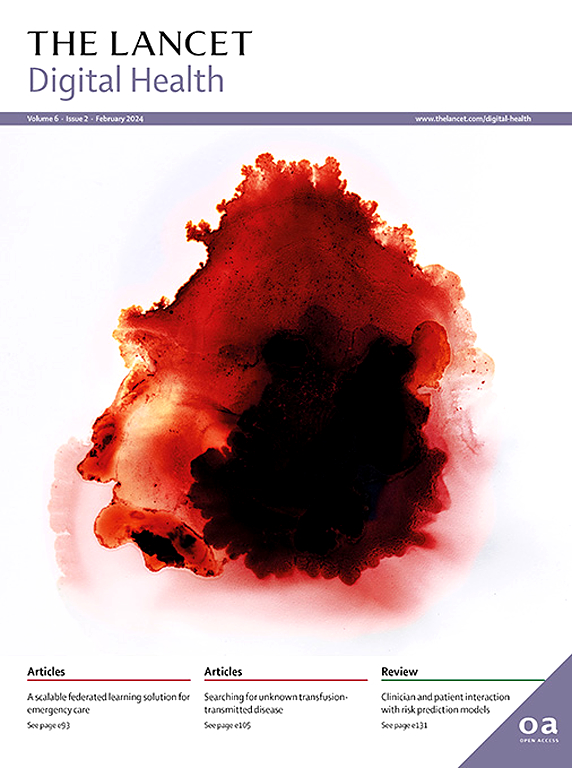A prospectively deployed deep learning-enabled automated quality assurance tool for oncological palliative spine radiation therapy
IF 23.8
1区 医学
Q1 MEDICAL INFORMATICS
引用次数: 0
Abstract
Background
Palliative spine radiation therapy is prone to treatment at the wrong anatomic level. We developed a fully automated deep learning-based spine-targeting quality assurance system (DL-SpiQA) for detecting treatment at the wrong anatomic level. DL-SpiQA was evaluated based on retrospective testing of spine radiation therapy treatments and prospective clinical deployment.
Methods
The DL-SpiQA workflow involves auto-segmentation and labelling of all vertebral volumes on CT imaging using TotalSegmentator, an open-source deep learning algorithm based on nnU-Net, calculation of the radiation dose to each vertebra, and flagging and categorisation of potential treatments at the wrong anatomic level with automated email reports sent to involved radiation therapy personnel. We developed the DL-SpiQA tool based on retrospective clinical data from patients treated with palliative spine radiation therapy from sites included in the multicentre hospital network between Feb 12, 2014, and Nov 15, 2022. We used historic cases of patients who had a near-miss (ie, wrong-anatomic-level errors caught before the patient was treated) or had received wrong-anatomic-level treatment to test whether the tool could identify known errors successfully. We then used the tool prospectively over 15 months (April 24, 2023, to July 22, 2024) to evaluate any new spine radiation therapy treatment plan created for a patient, looking for any targeting errors, and dose and volume discrepancies. An email report was circulated with all the radiation therapy personnel; if any errors were found, these were highlighted and each error was defined. The tool was internally validated. All cases flagged by DL-SpiQA for both the retrospective and prospective studies were manually reviewed for dosimetric targeting, variant spine anatomy or spinal anomalies, and artificial intelligence (AI) segmentation errors. DL-SpiQA was further validated based on false positive and negative rates estimated from the retrospective results.
Findings
DL-SpiQA was first tested retrospectively on 513 patients with segmentation of 10 106 vertebrae. The system raised flags for ten dose discrepancies, 49 normal anatomic variants, 49 cases with implants or other anomalies, and 20 segmentation errors (4% false positive rate). DL-SpiQA caught one historic treatment at the wrong anatomic level and three near-misses. DL-SpiQA was then prospectively deployed, reviewing 520 cases and identifying six documentation errors, which triggered detailed review by clinicians, and 43 additional cases, which confirmed clinical knowledge of variant anatomy. In all detected cases (ie, 49 of 520 cases in total), the appropriate personnel were alerted. A false negative rate of 0·03% is estimated based on the 4% AI segmentation error rate and the frequency of reported spine radiation therapy errors.
Interpretation
The low false positive rate, the low false negative rate, and the high accuracy in flagging errors show that DL-SpiQA is an effective, AI-driven, automated quality assurance tool that could be used to identify anatomic spine variants and errors in targeting at the anatomic level. The tool could therefore help improve the safety of spine radiotherapy. Further external validation and tailoring is needed.
Funding
None.
一种用于肿瘤姑息性脊柱放射治疗的前瞻性部署深度学习自动化质量保证工具。
背景:姑息性脊柱放射治疗容易在错误的解剖水平上进行治疗。我们开发了一个全自动的基于深度学习的脊柱靶向质量保证系统(DL-SpiQA),用于在错误的解剖水平上检测治疗。DL-SpiQA是基于脊柱放射治疗的回顾性测试和前瞻性临床部署来评估的。方法:DL-SpiQA工作流程包括使用TotalSegmentator(一种基于nnU-Net的开源深度学习算法)对CT成像上的所有椎体体积进行自动分割和标记,计算每个椎体的辐射剂量,并在错误的解剖水平上标记和分类潜在的治疗方法,并将自动电子邮件报告发送给相关的放射治疗人员。我们基于2014年2月12日至2022年11月15日期间多中心医院网络中接受姑息性脊柱放射治疗的患者的回顾性临床数据开发了DL-SpiQA工具。我们使用了一些历史病例,这些患者曾有过一次侥幸(即在患者治疗之前发现了错误的解剖水平错误)或接受过错误的解剖水平治疗,以测试该工具是否能够成功识别已知错误。然后,我们前瞻性地使用该工具超过15个月(2023年4月24日至2024年7月22日)来评估为患者创建的任何新的脊柱放射治疗计划,寻找任何靶向错误,剂量和体积差异。所有放射治疗人员都收到了一份电子邮件报告;如果发现任何错误,将突出显示这些错误,并定义每个错误。该工具进行了内部验证。所有在回顾性和前瞻性研究中被DL-SpiQA标记的病例都进行了人工审查,以确定剂量学靶向、脊柱解剖变异或脊柱异常以及人工智能(AI)分割错误。根据回顾性结果估计的假阳性和阴性率进一步验证DL-SpiQA。结果:DL-SpiQA首次在513例分割10106节椎骨的患者中进行回顾性试验。该系统对10例剂量差异、49例正常解剖变异、49例植入物或其他异常以及20例分割错误(假阳性率为4%)提出了警示。DL-SpiQA在一个错误的解剖水平上发现了一个历史性的治疗方法,还有三个险些失败。然后前瞻性地部署DL-SpiQA,审查了520例病例,并确定了6个文档错误,这引发了临床医生的详细审查,以及43个额外的病例,证实了变异解剖学的临床知识。在所有发现的病例中(即总共520例中的49例),都向适当人员发出了警报。根据4%的人工智能分割错误率和报道的脊柱放射治疗错误的频率,估计假阴性率为0.03%。解释:低假阳性率、低假阴性率和标记错误的高准确性表明DL-SpiQA是一种有效的、人工智能驱动的自动化质量保证工具,可用于识别解剖脊柱变异和解剖水平的靶向错误。因此,该工具可以帮助提高脊柱放射治疗的安全性。需要进一步的外部验证和裁剪。资金:没有。
本文章由计算机程序翻译,如有差异,请以英文原文为准。
求助全文
约1分钟内获得全文
求助全文
来源期刊

Lancet Digital Health
Multiple-
CiteScore
41.20
自引率
1.60%
发文量
232
审稿时长
13 weeks
期刊介绍:
The Lancet Digital Health publishes important, innovative, and practice-changing research on any topic connected with digital technology in clinical medicine, public health, and global health.
The journal’s open access content crosses subject boundaries, building bridges between health professionals and researchers.By bringing together the most important advances in this multidisciplinary field,The Lancet Digital Health is the most prominent publishing venue in digital health.
We publish a range of content types including Articles,Review, Comment, and Correspondence, contributing to promoting digital technologies in health practice worldwide.
 求助内容:
求助内容: 应助结果提醒方式:
应助结果提醒方式:


